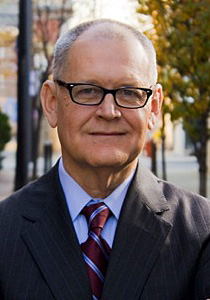Wendell Potter: Featured at HCAMn on June 21

Wendell Potter is a leading voice for health care reform and will speak at HCAMn’s annual gathering on June 21
Perhaps the biggest roadblock to implementation of single payer health care system is the for-profit insurance industry and its lobby. After all, who stands to lose the most with a health care system designed to take care of individuals rather than line the pockets of executives and shareholders? The United States remains the only industrialized nation in the world with a for-profit health care system.
HCAMn’s annual single payer summer celebration is Thursday June 21 and will feature Wendell Potter as its guest speaker. Information on how to purchase tickets can be found by clicking here. Following a 20-year career as a corporate public relations executive, Potter left his position as head of communications for CIGNA, one of the nation’s largest health insurers, to help socially responsible organizations — including those advocating for meaningful health care reform — achieve their goals.
Potter has been a powerful voice in exposing insurance companies and how they put profits before people. His latest book Deadly Spin provides not just an exposé of health insurers but a stark warning that corporate spin is distorting our democracy. Visit www.wendellpotter.com for more information on the book and the work Potter does.
Amid all the noise created by the passage of the Affordable Health Care Act (ACA) and its future now before the U.S. Supreme Court, there are some states who continue to move forward with the only common sense health care solution: single payer.
First it was Vermont, when Governor Peter Shumlin signed a law in March that sets Vermont on a course to provide health care for all of its citizens through a single payer system called Green Mountain Care. Key components include containing costs by setting reimbursement rates for health care providers and streamlining administration into a single, state-managed system. The ACA reform law would not allow Vermont to enact single payer until 2017; Vermont is asking the administration to grant it a waiver so that it can get there even faster, by 2014.
Vermont diligently and patiently worked for years to build the foundation for its law. So too, is Minnesota under the umbrella of an organization called Health Care for All Minnesota (HCAMn). Its mission is dedicated to establishing comprehensive single-payer health care for all Minnesotans through advocacy, education, lobbying, and community organizing. HCAMn, an independent organization that strategically partners with other organizations, is a nonpartisan, 501(c)4 non-profit and does not endorse candidates or work on political campaigns.
No matter what the Supreme Court decides, the move to single payer is on in Minnesota. In 2010, the Minnesota Health Act passed out of both state legislature committees before the November 2010 elections swept in a Republican controlled legislature and a Democratic governor (Mark Dayton). That effectively stalled the legislation even though Dayton is on record as supporting single payer for Minnesota.
“After the 2010 election, we decided our focus would be more to educate people on what single payer is,” said Erin Anderson, Executive Director of HCAMn. “We are now going state-wide, via forums and meetings, telling people what the benefits are, how it would save money and how everyone would be covered. We’re focused on education and organizing the general pubic.”
Minnesota is one state actively working to implement a health exchange as part of the ACA. The governor’s task forces on both health exchanges and health reform offer HCAMn other avenues to turn the conversation toward implementation of single payer.
“We, in an effort spearheaded by the Minnesota chapter of Physicians for a National Health Program, made a commitment to be at task force hearings and to speak during the public forum part of those meetings,” said Lisa Nilles, Vice Chair of HCAMn. “We’re showing up and making sure the message gets through to the governor. We’re also present at citizen forums organized by the Citizens League and helping to provide the governor input on what the citizens are saying about health care. And the message is getting out there that Minnesotans want single payer – that single payer needs to be on the table.”
Some national polls have shown a 2/3 majority in favor of single payer. A 2007 poll of Minnesota physicians indicated a 64 percent approval of single payer. Also, the majority of physicians (86%) agreed “that it is the responsibility of society, through the government, to ensure that everyone has access to good medical care.”
The HCAMn site provides excellent information on what single payer is and what it is not. It’s a great read for individuals concerned about knowing the facts about single payer. In summary, single payer provides:
- One system that covers everyone
- A uniform and comprehensive benefit set for everyone
- A single network of health care providers and an end to choice-limiting networks
- A single insurance pool to spread insurance risk
- An outlet to delink health care coverage from employment
“There’s so much misinformation about single payer,” Anderson said. “People think it’s ‘socialized medicine’ when in fact it’s not that at all. You still have private clinics and private hospitals, but they are paid by one payer and it doesn’t have to be the government. And people think it has to be so expensive, when all the studies show single payer saves money.”
Despite making sense and saving money, single payer faces an uphill climb with roadblocks thrown up by big insurance company lobbying. So what keeps HCAMn motivated through this long process?
“We have a fragmented health care system that keeps so many people from getting the care they need,” said Anderson, who herself carries the ‘scarlet letter’ of a pre-existing condition. “I had back surgery when I was 13,” she said. “I’m a pre-existing condition.
“It’s the stories – that’s what keeps us motivated. Everyone knows someone who has been affected by debt, who isn’t covered by health insurance, someone who has high deductibles or high prescription drug costs.”
For Nilles, a physician who worked in England in the early 1990s before beginning her practice in the U.S., it’s that first-hand knowledge of working in a system in which “everyone’s covered” that has been her motivating factor.
“I lived in a world where it (universal coverage) was just the norm,” Nilles said. “And then I came back and saw the crazy and chaotic system here. People here tend to push back and will cite horror stories about health care delivery in other countries, saying there is rationing and long lines. And they’re not looking at their own country. I ask: “what about here?’ We ration health care more than anyone, but people somehow think we have it better. I’ve been active in this for the last seven years, and single payer has become a real contender in the conversation – it seems to be more prevalent. People know what it is – even if they are afraid of it. And, once they hear it explained in some depth, they are not afraid, but often turn into supporters”
“In this country it tends to be the states have to do it first,” Anderson said. “The states are like pilot projects and they have to implement it and then it moves to a national level.”
“For a long term view, everything we are doing is building, and when will it break in favor of single payer? I don’t know, but I do know we are making progress and that is what gives us hope, Nilles said”
Single Payer: Common Sense & Cost Savings
HCAMn points to the recent Lewin Group report on what single payer would mean for Minnesota. The report once again states the obvious about single payer – it covers everyone and it saves money. A complete copy of the report is available by clicking here. Below is an excerpt:
Using health spending data provided by the Minnesota Department of Health (MDH), we estimate with our models that the single payer plan would achieve universal coverage while reducing total health spending for Minnesota by about $4.1 billion, or 8.8 percent, in 2014. This includes added costs due to reductions in utilization management and increased utilization costs resulting from reduced cost sharing. Additional costs and savings estimates under the single payer plan in 2014 include:
- A total savings of $35.7 million to state and local governments;
- An average savings of $1,214 per worker, for employers offering health insurance coverage prior to the ACA;
- An average additional cost of $1,963 per worker, for employers not offering health insurance coverage prior to the ACA;
- An average savings of $1,362 for families, including wage effects;
- A reduction of 42,800 Minnesota jobs for those with insurance-related job functions; and
- A ten year total statewide savings of $189.5 billion, from 2014-2023.



